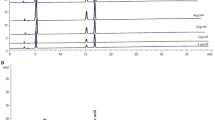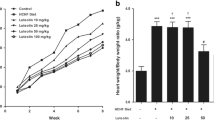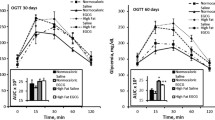Abstract
Background
Excessive intake of fat, one of the causes of obesity, is associated with low-grade inflammation in various susceptible organs and eventually causes tissue toxicity. This study examines the multifaceted suppressive effects of Korean red ginseng extract (KRG) on high-fat diet (HFD)-induced lipotoxicity and inflammatory responses in the aorta, liver, and brain.
Methods
Male C57BL/6 mice were fed HFD with or without KRG for 12 weeks. The improvement effect in KRG on lipotoxicity and inflammatory potential was determined in the blood and the aorta, liver, and brain tissues.
Results
KRG significantly inhibited 3-hydroxy-3-methylglutaryl coenzyme A (HMG-CoA) reductase activity by > 20% in vitro. KRG supplementation suppressed HFD-associated body weight gain, lipid profile changes, and excessive fat deposition in the liver and increased leptin, insulin, and ALT levels in the blood. Inflammatory markers in the aorta, liver, and brain were also significantly reduced by KRG treatment. In microvascular endothelial cells, the 15% cyclic stretch-mediated upregulation of ICAM-1 and vascular cell adhesion protein-1 (VCAM-1) expression was significantly attenuated in the presence of KRG.
Conclusion
KRG supplementation attenuates HFD-mediated body weight gain, lipid profile changes, and multi-tissue inflammatory responses.








Similar content being viewed by others
References
Acosta A, Dayyeh BKA, Port JD, Camilleri M (2014) Recent advances in clinical practice challenges and opportunities in the management of obesity. Gut 63:687–695
Burki T (2018) Alzheimer’s disease research: the future of BACE inhibitors. Lancet 391:2486
Carris NW, Tipparaju SM, Magness DJ, Chapalamadugu KC, Magness RR (2017) Pleiotropic effects of metformin to rescue statin-induced muscle injury and insulin resistance: a proposed mechanism and potential clinical implications. Med Hypotheses 107:39–44
Choi J, Kim TH, Choi TY, Lee MS (2013) Ginseng for health care: a systematic review of randomized controlled trials in Korean literature. PLoS One 8(e59978):59971–59974
Chu S et al (2014) Ginsenoside Rg5 improves cognitive dysfunction and beta-amyloid deposition in STZ-induced memory impaired rats via attenuating neuroinflammatory responses. Int Immunopharmacol 19:317–326
Duan Y et al (2018) Inflammatory links between high fat diets and diseases. Front Immunol 9:2649
Engin A (2017) Eat and death: chronic over-eating. Adv Exp Med Biol 960:53–80
Fotis L et al (2012) Intercellular adhesion molecule (ICAM)-1 and vascular cell adhesion molecule (VCAM)-1 at the early stages of atherosclerosis in a rat model. Vivo 26:243–250
Francisco V et al (2018) Obesity, fat mass and immune system: role for leptin. Front Physiol 9:1–20
Gadde KM, Martin CK, Berthoud H-R, Heymsfield SB (2018) Obesity: pathophysiology and management. J Am Coll Cardiol 71:69–84
Gangoda SVS et al (2018) Pulsatile stretch as a novel modulator of amyloid precursor protein processing and associated inflammatory markers in human cerebral endothelial cells. Sci Rep 8:1689
Haslam DW, James WPT (2005) Obesity. Lancet 366:1197–1209
Hsieh PS et al (2009) COX-2-mediated inflammation in fat is crucial for obesity-linked insulin resistance and fatty liver. Obesity (Silver Spring, Md.) 17:1150–1157
Hussain SS, Bloom SR (2011) The pharmacological treatment and management of obesity. Postgrad Med 123:34–44
Johnson AR, Milner JJ, Makowski L (2012) The inflammation highway: metabolism accelerates inflammatory traffic in obesity. Immunol Rev 249:218–238
Kasi PB et al (2018) The inhibitory effect of panax ginseng extract on amyloid-like fibril formation of trypsin in aqueous ethanol. Protein Pept Lett 25:253–259
Kim SN et al (2007) Simultaneous quantification of 14 ginsenosides in Panax ginseng CA Meyer (Korean red ginseng) by HPLC-ELSD and its application to quality control. J Pharm Biomed Anal 45:164–170
Kim HJ et al (2018) Panax ginseng as an adjuvant treatment for Alzheimer’s disease. J Ginseng Res 42:401–411
Koudinov AR, Koudinova NV (2005) Cholesterol homeostasis failure as a unifying cause of synaptic degeneration. J Neurol Sci 229–230:233–240
Langevin HM et al (2006) Fibroblast spreading induced by connective tissue stretch involves intracellular redistribution of alpha- and beta-actin. Histochem Cell Biol 125:487–495
Li Z, Ji GE (2018) Ginseng and obesity. J Ginseng Res 42:1–8
Lichtenstein AH et al (1998) Dietary fat consumption and health. Nutr Rev 56:S3–19 (discussion S19-28)
Livak KJ, Schmittgen TD (2001) Analysis of relative gene expression data using real-time quantitative PCR and the 2(-Delta Delta C(T)) Method. Methods 25:402–408
Mastrocola R et al (2011) Dysregulation of SREBP2 induces BACE1 expression. Neurobiol Dis 44:116–124
Musaad S, Haynes EN (2007) Biomarkers of obesity and subsequent cardiovascular events. Epidemiol Rev 29:98–114
Schaffer JE (2003) Lipotoxicity: when tissues overeat. Curr Opin Lipidol 14:281–287
So S-H, Lee JW, Kim Y-S, Hyun SH, Han C-K (2018) Red ginseng monograph. J Ginseng Res 42:549–561
Weksler BB et al (2005) Blood-brain barrier-specific properties of a human adult brain endothelial cell line. Faseb J 19:1872–1874
Wellen KE, Hotamisligil GS (2005) Inflammation, stress, and diabetes. J Clin Invest 115:1111–1119
Winzell MS, Ahrén B (2004) The high-fat diet-fed mouse: a model for studying mechanisms and treatment of impaired glucose tolerance and type 2 diabetes. Diabetes 53:S215–S219
Zhang H et al (2015) Content and activity of human liver microsomal protein and prediction of individual hepatic clearance in vivo. Sci Rep 5:1–12
Zhu Q, Zhu YY, Wang WN (2019) TRUSS inhibition protects against high fat diet (HFD)-stimulated brain injury by alleviation of inflammatory response. Biochem Biophys Res Commun 511:41–48
Zuckerman M, Greller HA, Babu KM (2015) A review of the toxicologic implications of obesity. J Med Toxicol 11:342–354
Acknowledgements
This work was supported by the 2016 Grant from the Korean Society of Ginseng and funded by the Korea Ginseng Corporation.
Author information
Authors and Affiliations
Contributions
S-AJ, SN, SRL and E-HS designed the research study. S-AJ, SN, JWL, YP, GS, SHK, M-JK, K-HJ, APA, SVSG, HJK, MKK and SCK performed the experiments and analysed data. S-AJ, SN, SRL and E-HS interpreted data and wrote the manuscript.
Corresponding author
Ethics declarations
Conflict of interest
Seon-A Jang, Seung Namkoong, Sung Ryul Lee, Jin Woo Lee, Yuna Park, Gyeongseop So, Sung Hyeok Kim, Mi-Ja Kim, Ki-Hyo Jang, Alberto P. Avolio, Sumudu V. S. Gangoda, Hyun Jung Koo, Myung Kyum Kim, Se Chan Kang and Eun-Hwa Sohn declare that they have no conflict of interest.
Human and animal rights
The experimental animal facility and study protocols were approved by the Animal Care and Use Committee of Kangwon National University (KW-161129-1). All experimental procedures were undertaken in compliance with the Guide for the Care and Use of Laboratory Animals (NIH Publications no. 8023, revised 1978) and the National Animal Welfare Law of the Republic of Korea.
Additional information
Publisher's Note
Springer Nature remains neutral with regard to jurisdictional claims in published maps and institutional affiliations.
Rights and permissions
About this article
Cite this article
Jang, SA., Namkoong, S., Lee, S.R. et al. Multi-tissue lipotoxicity caused by high-fat diet feeding is attenuated by the supplementation of Korean red ginseng in mice. Mol. Cell. Toxicol. 16, 39–50 (2020). https://doi.org/10.1007/s13273-019-00056-7
Accepted:
Published:
Issue Date:
DOI: https://doi.org/10.1007/s13273-019-00056-7




